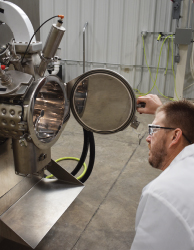Clean-In-Place (CIP) often appeals to food processors because on the surface, it seems like an easy methodology that can save labor costs and time in cleaning food processing equipment. Purchasing CIP equipment is a major investment, so it is important to take into account both the benefits and the potential problems with CIP before making the investment.
 One of the reasons that we do not always recommend CIP for Marion equipment is that the equipment is already designed for easy sanitation. Marion’s doors, valves, gaskets and spray units are ergonomically designed to make it easy to clean and inspect without any sophisticated add-on equipment. You may have other equipment in the factory that requires CIP, but often our customers find that the design of a Marion mixer makes it easier to forgo CIP, and instead use Rinse-In-Place (RIP) or manual cleaning, even for applications like dairy and ready-to-eat foods.
One of the reasons that we do not always recommend CIP for Marion equipment is that the equipment is already designed for easy sanitation. Marion’s doors, valves, gaskets and spray units are ergonomically designed to make it easy to clean and inspect without any sophisticated add-on equipment. You may have other equipment in the factory that requires CIP, but often our customers find that the design of a Marion mixer makes it easier to forgo CIP, and instead use Rinse-In-Place (RIP) or manual cleaning, even for applications like dairy and ready-to-eat foods.
CIP: It’s More Complex than It Looks
Clean-in-Place systems are generally self-contained units that include a way to both add and remove the cleaning materials. One thing that processors don’t always realize is that the chemicals used in CIP systems can be toxic and need special removal. Acid and caustic materials are great at removing just about any type of contamination in a mixer, but the next step is that you’ll need to thoroughly rinse these residues out of the mixer, and then properly dispose of the cleaning material. Also, if you are using this type of CIP equipment, your cleaning staff will need to be wearing the appropriate safety gear to protect their skin, eyes and respiratory organs. Furthermore, operators of CIP need to be experts, so if you are using a CIP system, you’ll need a staff of qualified and trained personnel.
In most jurisdictions, you can’t just dump out these caustic materials into the regular sewage system; you’ll need to have the appropriate drainage and removal facilities. Both the setup and disposal contribute to additional operation costs beyond the CIP system itself. For that reason, in the dairy industry, for example, a facility might use CIP equipment once per week, but have the routine daily cleaning done manually or using rinse-in-place.
Rinse-In-Place: A Clean Alternative
Rinse-In-Place (RIP) is worth considering for many processing solutions. RIP doesn’t use any caustic materials and can help cleaning the machines using either regular or high-pressure water spray to rinse equipment. The initial cleaning can be done with mops and brushes that reach into the equipment, using mild food-grade cleaning detergents. Using manual cleaning and RIP means that you can get equipment cleaned quickly and thoroughly while maintaining a safe environment.
Clean Out of Place (COOP)
You’d think that Clean-Out-Of-Place would be the opposite of Clean-In-Place, but frequently they are used in combination. No matter what type of CIP equipment you use, some parts should always be removable for cleaning. Valves and injection nozzles will always have too many intricate parts to be effectively cleaned while still in place in a mixer. For that reason, it’s best to choose a mixer with removable parts for cleaning out of place. You still may be using equipment for RIP or CIP, but those particular parts can be removed.
For most producers, having a duplicate set of parts means that they can use COOP without losing production time, because they can clean one set while replacing it with the second set. In addition to nozzles and valves, removable gaskets and choppers can make the cleaning much easier and faster, translating value directly to your bottom line.
What’s Best for You?
Determining the best solution depends on many factors―the type of materials you work with, the frequency of cleaning and the importance of efficiency in the cleaning process. With an easy-to-clean mixer such as the 3-A Authorized food mixers from Marion Process Solutions, manual or rinse-in-place is probably all you’ll need. In any case, you’ll want to leverage the expertise of your engineers and the equipment manufacturers to determine the best practices for your specific applications.